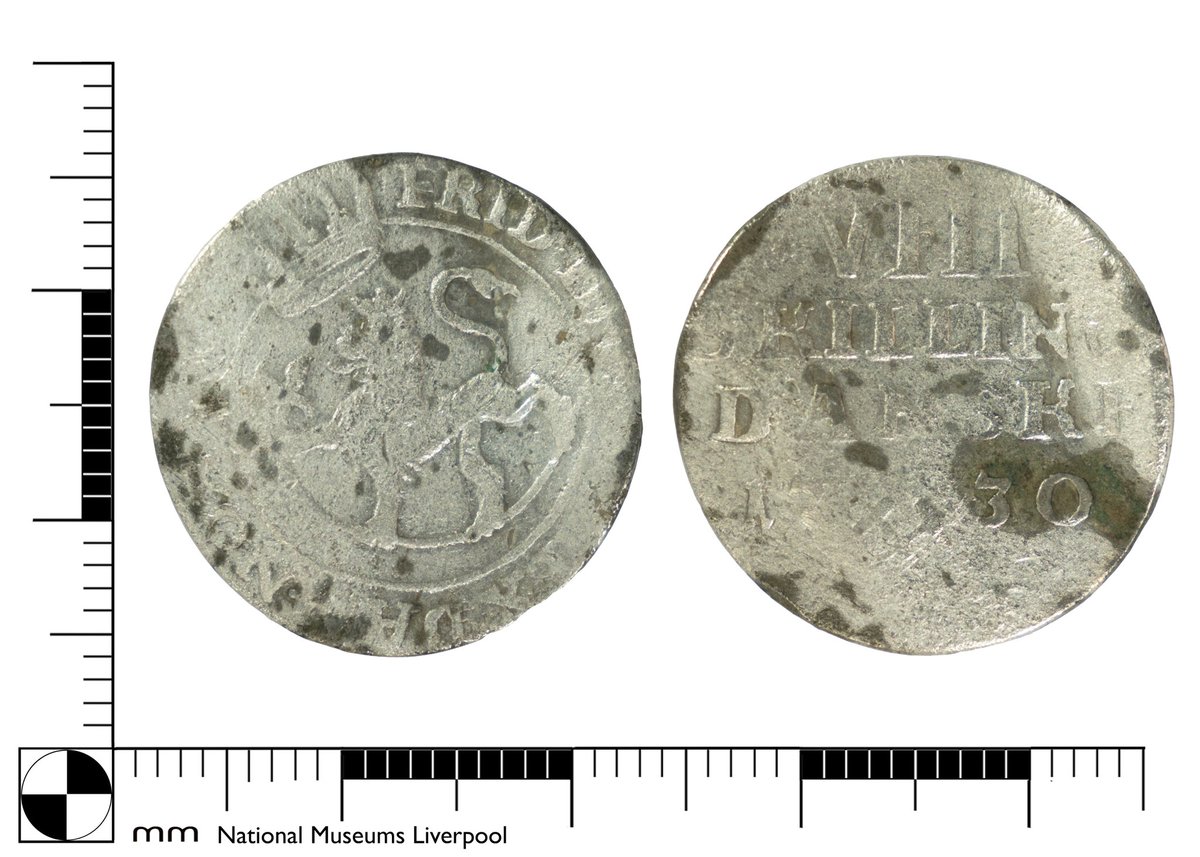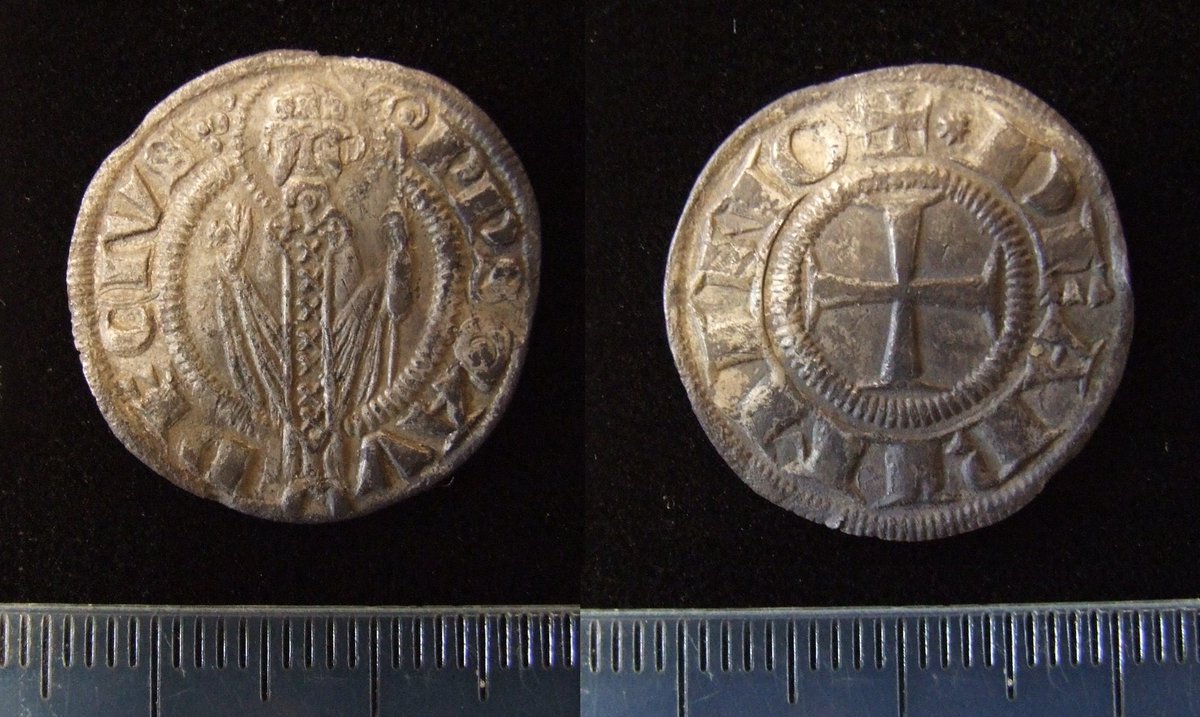
#Eurovisionfinds Cyprus - A medieval base silver (billon) denier of Henry II of the Kingdom of Cyprus (1285-1324) of 'lion' type probably dating to the period after 1296 (see notes below). Mint uncertain #Eurovision @findsorguk
finds.org.uk/database/artef…
finds.org.uk/database/artef…

#Eurovisionfinds Albania - A complete Post Medieval copper alloy Venetian 2 Soldi struck for use in Dalmatia and Albania dating from AD 1684 or 1691 #Eurovision
#ALB @CrapFinds
finds.org.uk/database/artef…
#ALB @CrapFinds
finds.org.uk/database/artef…

#Eurovisionfinds Israel - A cast lead pilgrim ampulla of Medieval, thirteenth to fifteenth century date. the ampulla is similar to a design for which a mould was found during excavations of a Medieval workshop in Akko (Acre) in Israel. #Eurovision
#ISR
finds.org.uk/database/artef…
#ISR
finds.org.uk/database/artef…

#Eurovisionfinds Belgium - Medieval silver continental imitation penny issued by Gui of Dampierre, Count of Flanders (AD 1251-1305) dating to 1288-1292 #Eurovision
#BEL
finds.org.uk/database/artef…
#BEL
finds.org.uk/database/artef…

#Eurovisionfinds Russia - Copper alloy Post Medieval commemorative medal dating to AD 1814.
The obverse depicts a left facing bust of the Emperor of Russia, Alexander with the inscription 'THE EMPEROR ALEXANDER' around the circumference. #Eurovision #RUS finds.org.uk/database/artef…
The obverse depicts a left facing bust of the Emperor of Russia, Alexander with the inscription 'THE EMPEROR ALEXANDER' around the circumference. #Eurovision #RUS finds.org.uk/database/artef…

#Eurovisionfinds Malta - Coin, possibly Maltese cross & there are C17-C18 century Maltese coins, issued by the Grand Masters of the Knights of Malta, with a similar pattern. This coin is cruder in EXECUTION. Dates between c1100 & c1800 AD. #Eurovision
#MLT
finds.org.uk/database/artef…
#MLT
finds.org.uk/database/artef…

#Eurovisionfinds Portugal - A complete gold Post Medieval quarter Moeda with a value of 1000 Reis of Peter II (Dom Pedro II) of Portugal (AD 1648-1706). Coin is dated to AD 1703. Mint uncertain. #Eurovision
#POR
finds.org.uk/database/artef…
#POR
finds.org.uk/database/artef…

#Eurovisionfinds Serbia - A silver Roman siliqua of Constantius II (AD 337-61), dating to the period AD 355 - 361 (Reece Period 18), VOTIS/XXX/MVLTIS/XXXX in wreath, Sirmium (modern Sremska Mitrovica, Serbia). RIC VIII, p. 389, no. 68. #Eurovision
#SRB
finds.org.uk/database/artef…
#SRB
finds.org.uk/database/artef…

#Eurovisionfinds United Kingdom - A modern button of the Stockbridge Labourers' Friends' Association, founded by Lord Shaftesbury in the United Kingdom in 1830 for the improvement of working class conditions. #Eurovision
#UK
finds.org.uk/database/artef…
#UK
finds.org.uk/database/artef…

#Eurovisionfinds Greece - Copper alloy coin of the city of Eretria on the Greek island of Euboea c. 196-146 BC Reference: BMC Central Greece, p. 98, c.f. 34-35. #Eurovision #GRE
finds.org.uk/database/artef…
finds.org.uk/database/artef…

#Eurovisionfinds Switzerland - A modern bronze coloured brooch or pin originating from Switzerland dating to AD 1949. #Eurovision #SUI
finds.org.uk/database/artef…
finds.org.uk/database/artef…

#Eurovisionfinds Iceland - Incomplete silver Viking Mjolnir (Thor's hammer) pendant. The pendant is in the form of a rectangular cross-section, inverted 'T'-shape. They are found distributed in areas of Viking settlement, including Iceland #Eurovision #ISL finds.org.uk/database/artef… 

#Eurovisionfinds Spain - An extremely worn silver post Medieval 1/2 Real of Ferdinand and Isabella of Spain, dating to 1497-1566. Uncertain mint. #Eurovision #ESP finds.org.uk/database/artef… 

#Eurovisionfinds Moldova - An incomplete Roman enamelled copper alloy zoomorphic continental plate brooch in the shape of a panther paralleled with an example from Moldova #Eurovision #MDA
finds.org.uk/database/artef…
finds.org.uk/database/artef…

#Eurovisionfinds Germany - A silver medieval groschen of the city Köln (Cologne), Germany. Probably dating to c.1475, minted at Köln, mint mark cross fleury. #Eurovision #GER
finds.org.uk/database/artef…
finds.org.uk/database/artef…

#Eurovisionfinds Finland - Early post-Medieval hammered coin from Livonia, probably an issue of the Grand Master Hermann Hasenkamp von Brüggeneye (1535-1549). Livonia was an area in the medieval period which is now Estonia and Finland. #Eurovision #FIN
finds.org.uk/database/artef…
finds.org.uk/database/artef…

#Eurovisionfinds Bulgaria - A medieval silver grosso from Medieval Bulgaria, produced under Ivan Alexander, (1331-1371), mint: Tarnarvo (Bulgaria), type КБМ 1.13.3 (МПТ Т. 11.2; OJN Т. I.8), the design derived from the Venetian Grosso. #Eurovision
#BUL
finds.org.uk/database/artef…
#BUL
finds.org.uk/database/artef…

#Eurovisionfinds Lithuania - A Post-Medieval copper-alloy solidus of John II Casimir of Poland, Grand Duke of Lithuania. Dated 1666 on coin. #Eurovision #LTU
finds.org.uk/database/artef…
finds.org.uk/database/artef…

#Eurovisionfinds Ukraine - A complete cast lead circular Russian control seal of 19th century date. The left hand image contains the word СМѣ.ЛА - older Russian Cyrillic for the town of Smila in Ukraine. #Eurovision #UKR
finds.org.uk/database/artef…
finds.org.uk/database/artef…

#Eurovisionfinds France - A clipped post-Medieval silver quarter-ecu of Louis XIII of France (1610-1643). #Eurovision #FRA
finds.org.uk/database/artef…
finds.org.uk/database/artef…

#Eurovisionfinds Azerbaijan - it's all coming apart, we don't have anything for Azerbaijan 😔 #Eurovision #AZE 

#Eurovisionfinds Norway - Silver post medieval Norwegian 8 skilling of Frederik IV (AD 1699-1730) dated to 1730. Mint master unclear. #Eurovision #NOR
finds.org.uk/database/artef…
finds.org.uk/database/artef…

#Eurovisionfinds The Netherlands -
A Post Medieval silver 1-stuiver of Overjissel of the United Provinces of the Netherlands dating to AD 1628.
#Eurovision #NED
finds.org.uk/database/artef…
A Post Medieval silver 1-stuiver of Overjissel of the United Provinces of the Netherlands dating to AD 1628.
#Eurovision #NED
finds.org.uk/database/artef…

#Eurovisionfinds Italy - A medieval silver soldino of Doge Nicolo Tron (1466-73), mint: Venice (Italy). #Eurovision #ITA
finds.org.uk/database/artef…
finds.org.uk/database/artef…

#Eurovisionfinds Sweden - A Post Medieval copper quarter Or from the reign of Queen Christina (AD 1632-1654) of Sweden. The House of Vasa ruled Sweden from 1523 until 1654 on Christina's death #Eurovision #SWE
finds.org.uk/database/artef…
finds.org.uk/database/artef…

#Eurovisionfinds San Marino - Continental silver Grosso of of Saint Gaudecius, Rimini, Italy, where St. Marinus, founder of San Marino rebuilt the city walls #Eurovision #SMR
finds.org.uk/database/artef…
finds.org.uk/database/artef…

• • •
Missing some Tweet in this thread? You can try to
force a refresh




